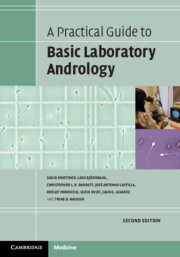Book contents
- A Practical Guide to Basic Laboratory Andrology
- A Practical Guide to Basic Laboratory Andrology
- Copyright page
- Contents
- Abbreviations
- Chapter 1 Introduction
- Chapter 2 Basic Physiology
- Chapter 3 Basic Semen Examination
- Chapter 4 Extended Semen Analysis
- Chapter 5 Sperm DNA
- Chapter 6 Computer-Aided Sperm Analysis
- Chapter 7 Sperm Function Tests
- Chapter 8 Tests of Sperm-Cervical Mucus Interaction
- Chapter 9 Sperm Preparation
- Chapter 10 Sperm Cryopreservation
- Chapter 11 Preparation of Surgically Retrieved Spermatozoa
- Chapter 12 Quality Management and Accreditation
- Chapter 13 Risk Management
- Chapter 14 Reproductive Toxicology
- Chapter 15 Andrology Laboratory Safety
- Book part
- Index
- References
Chapter 6 - Computer-Aided Sperm Analysis
Published online by Cambridge University Press: 16 February 2022
- A Practical Guide to Basic Laboratory Andrology
- A Practical Guide to Basic Laboratory Andrology
- Copyright page
- Contents
- Abbreviations
- Chapter 1 Introduction
- Chapter 2 Basic Physiology
- Chapter 3 Basic Semen Examination
- Chapter 4 Extended Semen Analysis
- Chapter 5 Sperm DNA
- Chapter 6 Computer-Aided Sperm Analysis
- Chapter 7 Sperm Function Tests
- Chapter 8 Tests of Sperm-Cervical Mucus Interaction
- Chapter 9 Sperm Preparation
- Chapter 10 Sperm Cryopreservation
- Chapter 11 Preparation of Surgically Retrieved Spermatozoa
- Chapter 12 Quality Management and Accreditation
- Chapter 13 Risk Management
- Chapter 14 Reproductive Toxicology
- Chapter 15 Andrology Laboratory Safety
- Book part
- Index
- References
Summary
Discusses the development, application and limitations of computer-aided sperm analysis (CASA) methods, including the deriation of kinematic measures of human sperm motility. Explains the technical and biological factors that limit CASA's functionality for human semen analysis and summarizes expert recommendations on the use of CASA for human semen analysis and sperm kinematics analysis (including sperm-mucus penetration and sperm hyperactivation). Issues related to the non-comparability of different CASA systems are considered, along with quality control for CASA. A strategy for validating a CASA system for human semen analysis, based on expectations of accuracy and precision, is also provided. Finally the use of CASA for analyzing sperm function tests, and new and future CASA technology (including the application of artificial intelligence technqiues) are surveyed.
Keywords
- Type
- Chapter
- Information
- A Practical Guide to Basic Laboratory Andrology , pp. 130 - 154Publisher: Cambridge University PressPrint publication year: 2022



